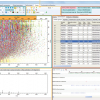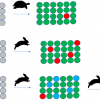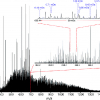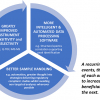Nikunj R. Parikh, Michelle Romm and Vaughn P. Miller
Agilent Technologies, Inc. Wakefield, Massachusetts, USA. E-mail: [email protected]
Introduction
Bath salts, the informal “street” name for a new family of designer drugs, are synthetic cathinones with effects similar to amphetamines or cocaine. Bath salts can be modified structurally and synthesised easily, preventing them from being detected in regular forensic drug screening. In this article, we present an ultrafast method for screening a panel of six bath salts in urine samples using a high-throughput mass spectrometry system. The bath salts were analysed accurately and precisely measured within a linear range of 31–1000 ng mL–1. Increased sensitivity and specificity were achieved compared to traditional screening methods without compromising throughput and speed.
Synthetic cathinones are derived from cathinone, a psychoactive component of the khat plant (Catha edulis Forsk). While cathinone derivatives have previously been used as active pharmaceutical ingredients in licensed pharmaceuticals (for example, amfepramone), the last decade has seen unregulated ring-substituted cathinone derivatives enter the recreational drugs market.1 These derivatives include methcathinone (ephedrone), mephedrone (4-methylmethcathinone, 4-MMC), methylone (bk-MDMA; 3,4-methylenedioxy-N-methylcathinone), MDPV (3,4-methylenedioxypyrovalerone), methedrone (bk-PMMA; 4-methoxymethcathinone) and PPP (a-pyrrolidinopropiophenone). Whereas cathinone itself and methcathinone are regulated, other derivatives are yet to come under international control— although Europe has now enacted a ban on mephedrone and the US Drug Enforcement Agency (DEA) has placed a temporary ban on mephedrone, MDPV and methylone, classifying them as schedule I (“no currently accepted medical use and a high potential for abuse”) status.1,2,3
Cathinone derivatives are powerful psychoactive stimulants, with similar effects to amphetamines, and the lack of regulation has led to their being marketed as “legal highs”, being labelled as “bath salts” or “plant food” and with packaging marked “not for human consumption” in order to circumvent detection,1 with a recent US study identifying as many as 37 different brand names reported among 236 patients treated for exposure to bath salts.4 The use of bath salts presents a significant public health risk, with increased reports of toxicity and mortality, and medical reports of bath salts users presenting with tachycardia, hypertension, hyperthermia, seizures, severe panic attacks, agitation, paranoia, hallucinations and violent behaviour (including self-mutilation, suicide attempts and homicidal activity).5,6
Bath salts can be modified structurally and synthesised easily, preventing them from being detected during regular drug screening. Traditional forensic drug testing relies on immunoassay screening followed by gas chromatography/mass spectrometry (GC/MS) and, more recently, liquid chromatography/ mass spectrometry (LC/MS) for quantitative analysis. The need for greater throughput, faster turn-around times, and increased specificity have placed increased demands on these traditional technologies. In the present study, a method to screen urine for a six-drug panel consisting of mephedrone, methylone, methcathinone, fluoromethcathinone, methoxymethcathinone and MDPV (Figure 1) was developed using a high-throughput MS system—a solid phase extraction with tandem mass spectrometry (SPE/MS/MS) system capable of analysing samples with cycle times under 15 s.

Experimental
The high-throughput MS system was a RapidFire MS/MS system (Agilent Technologies, Inc.), which consists of an ultrafast autosampler and online SPE instrument, a triple quadrupole mass spectrometer, and proprietary qualitative and quantitative analysis software. Samples were analysed at a rate of 14 s per sample. The conditions used maybe found as Table S1 in the online supplementary information. The standard curve for the injection cycle may also be found in the online supplementary material section and is shown there as Figure S1. Analyte and internal standard ions were monitored simultaneously in all experiments for all six bath salt drugs.
Mephedrone, methylone, methcathinone, fluoromethcathinone, methoxymethcathinone and MDPV (all at 1 mg mL–1 in methanol) and mephedrone-d3 (100 µg mL–1 in methanol), were purchased from Cerilliant, Round Rock, TX, USA. All other LC/MS grade solvents and reagents were purchased from Sigma–Aldrich, St Louis, MO, USA.
Standard calibrators were prepared by spiking drug-free human urine with 1000 ng mL–1 of mephedrone, methylone, methcathinone, fluoromethcathinone, methoxymethcathinone and MDPV. Two-fold serial dilutions were used to achieve the remaining standard calibrator concentrations. A set of standard calibrators containing all six analytes within a concentration range of 31–1000 ng mL–1, as well as a negative matrix control were also spiked with 100,000 ng mL–1 of the same class of interfering drugs: methylenedioxyamphetamine (MDA), methylenedioxymethamphetamine (MDMA), methylenedioxyethylamphetamine (MDEA), amphetamine, methamphetamine ephedrine and pseudoephedrine.
All samples were diluted 1 : 10 using water containing isotopically-labelled methylone-d3 as a common internal standard (100 ng mL–1 final concentration). Samples were transferred to 96-well plates, centrifuged and injected onto the MS/MS system. Prepared calibration standards were run four times a day, over a series of four days, to establish both intra- and inter-day precision and accuracy. The reproducibility of the method was tested by measuring 2000 sequential injections of all six analytes spiked into urine at 100 ng mL–1. The same cartridge was used for all 2000 injections without deviation in pump pressures or peak shape.
Qualitative analysis and quantitative analysis software were used for data analysis. A 1 / ×2 weighting factor was applied during linear regression of the calibration curves. The quantitation was performed by spectral peak area ratio to a known concentration of the internal standards.
Results and discussion
Mephedrone, methylone, methcathinone, fluoromethcathinone, methoxymethcathinone and MDPV had intra- and inter-day accuracies within 15% and coefficient of variation values less than 10% for all concentrations within the linear range. This method had linearity within the measured range of 31–1000 ng mL–1 with an R2 value > 0.998 for each analyte. Only the accuracy and precision measures (Table 1) and the standard curve linearity (Figure 2) are presented here for methylone; details and results for the other analytes are given in the online supplementary material section. The limit of quantitation (LOQ) was determined to be 31 ng mL–1 for all six analytes.
Table 1. Intra-day and Inter-day precision and accuracy for RapidFire/MS/MS analysis of methylone in urine.
Methylone | Intra-day % | Intra-day % | Inter-day % | Inter-day % |
31.25 | 106.2 | 1.8 | 107.4 | 2.0 |
62.5 | 92.7 | 3.9 | 90.2 | 3.4 |
125 | 92.6 | 3.7 | 91.5 | 4.9 |
250 | 93.3 | 3.4 | 95.5 | 2.5 |
500 | 97.4 | 2.1 | 98.1 | 2.4 |
1000 | 103.0 | 2.0 | 103.0 | 2.7 |

No suppression was observed for any of the six analytes when 100,000 ng mL–1 of MDA, MDMA, MDEA, amphetamine, methamphetamine, ephedrine and pseudoephedrine were present in the sample. Mephedrone, methylone, methcathinone, fluoromethcathinone, methoxymethcathinone and MDPV were all accurately measured, even at the lower end of the linear range, despite the presence of high concentrations of the other drugs. The negative matrix control was also tested and determined to be void of any interference from these drugs.
In the reproducibility tests, the instrument response was stable for all six analytes. For example, methylone had a coefficient of variation of 2.05% and accuracy within 2% (Figure 3).

Conclusions
The panel of six bath salts was quickly, accurately and precisely quantitated in urine using a simple “dilute and shoot” (direct sample injection) method. With peak-to-peak injection cycle times of 14 s, this screening method is capable of throughputs greater than 240 samples per hour. Using this SPE/MS/MS methodology, increased sensitivity and specificity were achieved compared to traditional screening methods without compromising throughput and speed. The ability to add more analytes to this panel further broadens the potential use of this analysis system for the detection of cathinone derivatives within human urine samples.
References
- Synthetic cathinones: drug profile, European Monitoring Centre for Drugs and Drug Addiction. Available at: http://www.emcdda.europa.eu/publications/drug-profiles/synthetic-cathinones, accessed July 2013.
- “Mephedrone ban across the EU”, Drugnet Europe. 73, (2011). Available at: http://www.emcdda.europa.eu/publications/drugnet/online/2011/73/article2, accessed July 2013.
- US Drug Enforcement Administration. Drug facts sheet: Bath salts. Available at: http://www.justice.gov/dea/druginfo/drug_data_sheets/Bath_Salts.pdf Accessed July 2013.
- H.A. Spiller, M.L. Ryan, R.G. Weston and J. Jansen, “Clinical experience with and analytical confirmation of “bath salts” and “legal highs” (synthetic cathinones) in the United States”, Clin. Toxicol. (Phila). 49, 499 (2011).
- T.D. Olives, B.S. Orozco and S.J. Stellpflug, “Bath salts: the ivory wave of trouble”, West J. Emerg. Med. 13, 58 (2012). doi: 10.5811/westjem.2011.6.6782
- E.A. Ross, M. Watson and B. Goldberger, “’Bath Salts’ Intoxication”, N. Engl. J. Med. 365, 967 (2011). doi: 10.1056/NEJMc1107097
Supplementary Material
Table S1. RapidFire conditions.
Buffer A | Water with 0.09% formic acid, 0.01% trifluoroacetic acid | |||||
Buffer B | 50% methanol, 50% isopropanol, 0.09% formic acid, 0.01% trifluoroacetic acid | |||||
Injection volume | 10 µL | |||||
SPE cartridge | Agilent RapidFire cartridge A2 (reversed-phase C4, G9210A) | |||||
RF State 1 | sip sensor | |||||
RF State 2 | 3000 ms | |||||
RF State 3 | 7500 ms | |||||
RF State 4 | 500 ms | |||||
Triple quadrupole conditions | ||||||
Gas temperature | 300°C | |||||
Gas flow | 12 L min–1 | |||||
Nebulizer | 45 psi | |||||
Sheath gas temperature | 350°C | |||||
Sheath gas flow | 11 L min–1 | |||||
Nozzle voltage | 0 V | |||||
Capillary voltage | 4000 V | |||||
MRM transitions | ||||||
Analyte | Q1 | Q3 | Dwell | Fragmentor | CE | CAV |
3,4–MDPV | 276.1 | 205 | 20 | 380 | 15 | 3 |
Methylone–d3 | 211.1 | 163 | 20 | 380 | 15 | 3 |
Methylone | 208.1 | 160 | 20 | 380 | 15 | 3 |
3-Methoxymethcathinone | 194.1 | 161.1 | 20 | 380 | 20 | 3 |
3-Fluoromethcathinone | 182.1 | 149.1 | 20 | 380 | 20 | 3 |
Mephedrone | 178.1 | 145.1 | 20 | 380 | 20 | 3 |
S(–) Methcathinone | 164.1 | 131.1 | 20 | 380 | 20 | 3 |
Table S2. Intra-day and Inter-day precision and accuracy for RapidFire/MS/MS analysis of mephedrone in urine.
Mephedrone | Intra-day % | Intra-day % | Inter-day % | Inter-day % |
31.25 | 106.1 | 1.1 | 106.7 | 0.7 |
62.5 | 95.1 | 2.7 | 94.3 | 1.6 |
125 | 89.7 | 2.1 | 87.5 | 1.2 |
250 | 89.8 | 3.1 | 92.5 | 2.5 |
500 | 95.9 | 2.1 | 96.6 | 2.1 |
1000 | 103.7 | 1.7 | 104.3 | 1.1 |
Table S3. Intra-day and Inter-day precision and accuracy for RapidFire/MS/MS analysis of methcathinone in urine.
Methcathinone | Intra-day % | Intra-day % | Inter-day % | Inter-day % |
31.25 | 102.7 | 2.2 | 103.2 | 2.9 |
62.5 | 101.1 | 4.9 | 100.1 | 6.0 |
125 | 89.3 | 4.6 | 87.4 | 2.0 |
250 | 93.7 | 2.8 | 96.8 | 3.8 |
500 | 98.9 | 2.8 | 99.4 | 3.7 |
1000 | 103.9 | 3.2 | 104.9 | 2.9 |
Table S4. Intra-day and Inter-day precision and accuracy for RapidFire/MS/MS analysis of fluoromethcathinone in urine
Fluoromethcathinone | Intra-day % | Intra-day % | Inter-day % | Inter-day % |
31.25 | 104.1 | 4.7 | 101.7 | 4.0 |
62.5 | 97.4 | 9.4 | 100.9 | 8.4 |
125 | 93.0 | 4.3 | 92.3 | 2.0 |
250 | 95.3 | 3.0 | 98.5 | 2.9 |
500 | 97.9 | 3.1 | 97.9 | 2.1 |
1000 | 103.5 | 2.8 | 101.6 | 3.4 |
Table S5. Intra-day and Inter-day precision and accuracy for RapidFire/MS/MS analysis of methoxymethcathinone in urine.
Methoxymethcathinone | Intra-day % | Intra-day % | Inter-day % | Inter-day % |
31.25 | 103.0 | 1.6 | 102.3 | 1.2 |
62.5 | 101.3 | 3.6 | 103.5 | 2.4 |
125 | 89.9 | 2.5 | 87.3 | 1.8 |
250 | 89.6 | 3.2 | 91.4 | 4.0 |
500 | 97.0 | 2.3 | 98.0 | 2.2 |
1000 | 104.3 | 2.0 | 104.3 | 2.0 |
Table S6. Intra-day and Inter-day precision and accuracy for RapidFire/MS/MS analysis of MDPV in urine.
MDPV | Intra-day % | Intra-day % | Inter-day % | Inter-day % |
31.25 | 106.9 | 3.0 | 106.0 | 0.7 |
62.5 | 94.5 | 2.5 | 94.5 | 1.8 |
125 | 93.7 | 3.6 | 90.3 | 1.0 |
250 | 88.3 | 2.3 | 91.7 | 2.6 |
500 | 96.1 | 2.8 | 97.5 | 1.9 |
1000 | 103.5 | 1.7 | 102.8 | 0.7 |




















